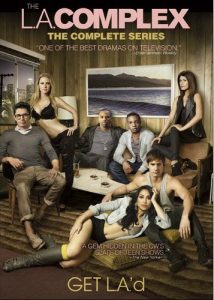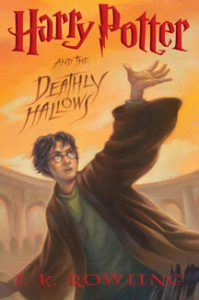For the 20th anniversary of “Harry Potter,” I’m looking back at the books and films of J.K. Rowling’s Wizarding World saga.
The seventh and final book in J.K. Rowling’s boy wizard saga, “Harry Potter and the Deathly Hallows” (2007), is the one I most underrated on my first read. Perhaps it plays better with the first six books fresh in a reader’s mind, rather than as a detached experience two years removed from the prior entry. In almost every way, “Deathly Hallows” is different from the first six novels – notably by not following the school-days structure – but the jarring changes are ultimately what makes it a great work of literature, even as it asks more of a reader.
It’s a bittersweet rush to maturity for Harry, Ron and Hermione as they are forced to quickly abandon Bill and Fleur’s wedding when it is attacked by Death Eaters in Chapter 8. Hermione is a mother figure, as she plans ahead to bring her magic bag filled with a magic tent, the Invisibility Cloak and changes of clothes. Ron comes through when it counts, seemingly abandoning his friends only to return and rescue Harry. Harry earns his status as the inspirational figure, as he’s willing to die to stop Voldemort; we see how Neville Longbottom (the Bean to Harry’s Ender Wiggins) has picked up Harry’s slack back at the school, with Ginny and Luna as his sidekicks.
The central trio uses their time on the run from Voldemort’s lackeys to also search for Horcruxes. As a quest story, this one is unusual, because for long stretches they make no progress. Surprisingly, it’s still a good read, as the trio’s friendship and perseverance are tested against their fiercest enemies – boredom and a lack of hope. Fitting but sobering, Rowling almost entirely sets aside her sense of humor. The closest thing to humor is the dark variety, like when the trio argues about who should risk themselves in the fight, and the conversation turns sarcastic: “Fine, I’ll stay here,” said Harry. “Let me know if you ever defeat Voldemort, won’t you?” Or when a moment gets tense enough that Hermione actually “swears” (“Merlin’s pants!”).
There are times when Harry, Ron and Hermione rely on what they’ve learned at Hogwarts: “Are you a wizard or not?!,” Hermione prods Ron (a callback to his line from “Sorcerer’s Stone”), and he casts a successful spell in the epic Chapter 31, “The Battle of Hogwarts.” The O.W.L.’s in Year 5 and the N.E.W.T.’s in Year 7 (which the main characters don’t take) are the formal tests, but the events of “Deathly Hallows” are the ultimate test, even as the trio soaks up knowledge “on the job.” Harry, Ron and Hermione do not graduate in the pages of this book, but Rowling does not draw attention to it, and her very silence on the matter might be the ultimate subversive statement about public schooling.
Some epics – even great ones – struggle with a sense of inevitability in their final chapter. “Return of the Jedi” (the weakest of the original “Star Wars” trilogy) doesn’t have many fresh surprises, nor does “Buffy’s” final season (the weakest of the seven). “Deathly Hallows” is partly an exercise in tying everything together, and it does possess a rather blatant flaw that is overlooked or excused by most readers: Our heroes simply guess what all the Horcruxes are, and they never guess wrong. If they weren’t such good guessers, or if Voldemort had been cleverer in making Horcruxes, the story would’ve turned out quite differently.

Yet it’s just as much of a page-turner as the earlier books, when we were marveling at Rowling’s world-building. This is primarily because the author doesn’t pull back the curtain until the end on the full stories of 1) Dumbledore’s plans for Harry, and 2) the allegiance of Snape, a double agent who unambiguously kills Dumbledore in Book 6. Two posthumously revelatory chapters — “The Prince’s Tale” (33) and “King’s Cross” (35) — are worth the wait.
Snape comes into focus as a tragic hero who did everything for the unrequited love of his childhood best friend, Lily Potter. Dumbledore – whose greatness comes into question earlier in the book, as Rita Skeeter’s “The Life and Lies of Albus Dumbledore” is published – reveals himself to be a flawed human, but still likeable for it, in a white room scene that offers a nice reprieve from the climactic wand-crossing between Harry and Voldemort back on mortal soil.
The neatest hidden gem of “Deathly Hallows” is that, while it is a satisfying conclusion, it does just as much (maybe more) world-building as the previous books, and to this day we’re still getting new stories that spring from it. The in-universe “The Tale of the Three Brothers” provides a clue in Harry’s quest for the Hallows, and it would be published in its entirety (along with other stories) a year later in “Tales of Beedle the Bard.”
We learn about Dumbledore’s childhood friendship with Grindelwald, the villain of a previous generation. The Grindelwald saga is now unfolding in the five-film “Fantastic Beasts and Where to Find Them” series, written by Rowling. (On a somewhat related note, Dumbledore’s old friend Doge can be read as a former lover of Dumbledore now that we’re armed with Rowling’s 2009 revelation that the headmaster was gay.) And “Deathly Hallows’ ” epilogue doubles as the prologue to “Book 8,” the stage play “Harry Potter and the Cursed Child” (2016).
But back in 2007, the biggest talking point leading up to this book’s release was Harry’s fate. To me, it was common sense that he’d survive (and I wrote a prediction piece for the newspaper where I worked), if only because killing Harry would be an insanely off-point way to end a children’s series. Plus, the hero survives almost all “hero’s journey” stories; it’s their mentors and helpers that aren’t always so lucky.
But a lot of fans thought Harry was doomed. So it’s interesting that Harry’s own fatalism comes to the fore in Chapters 33 and 34, and that his willingness to die for the cause is why he survives and defeats Voldemort. (While heroes don’t often die at the end of their journeys, some of them metaphorically “die” along the way, as Buffy and Angel do multiple times, and as Harry does during the “King’s Cross” reprieve.)
“Deathly Hallows” lives up to its grim title both in the bleakness of the trio’s quest and in the deaths of beloved characters like Moody, Dobby, Fred, Lupin and Tonks — the latter two of whom suffer off-page demises, a way to show how the horror of battle strikes Harry.
Still, once that heavy price has been paid, Rowling manages to paint a rather uplifting picture of how to overthrow oppressive regimes, reminding us that they are not all-powerful and eternal, and that on the other side, all will be well again.
Here are my rankings of the seven books (all of which I adore even more after this re-read): 6, 4, 7, 3, 5, 1, 2. Share your own rankings in the comment thread below.
Movie reviews: “Deathly Hallows, Part 1” “Deathly Hallows, Part 2”
Next book: “Cursed Child” stage play

